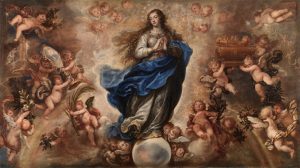Ord Om ordet
Immaculate Conception
Formed as we are to a scientific mindset, we think of the way things happen in terms of cause and effect. You flick a switch and the light comes on. Interest rates rise, and consumer habits change. Factories in Newcastle send out noxious fumes, and Norwegian reindeer go bald. Our gadgets, our economy, our fragile ecosystem: all seem to obey this fundamental law of causation. It is easy to assume that it’s simply the way things are. Let’s be wary of that assumption, especially in matters of theology. Today’s feast, crucial to the unravelling of our redemption, rejoices in effects that precede their cause. The Immaculate Conception of the Blessed Virgin Mary is not some myth of romantic purity removing the Mother of God from humanity’s common run whose stains we know all to well. The message of this feast is not that Mary did not need to be redeemed. On the contrary, she is, we might say, more redeemed than anyone else, the recipient of a unique outpouring of grace. What this means is set out in the Collect for the feast. It is a dense prayer, perhaps a little clunkily phrased, at least in translation. It requires us to read it analytically, in careful meditation. It is an excellent text for lectio divina. Let us quite simply consider its three articulations.
The first part of the prayer sets out what the mystery is for: ‘O God, who by the Immaculate Conception of the Blessed Virgin prepared a worthy dwelling for your Son’. As always, in time and eternity, Mary points away from herself to her Son; she is what she is for his sake. Her sinlessness is not a personal prerogative. It prepares the incarnation of the Word, so that he, fully divine, might no less fully assume an integral humanity, as God first intended and made it; not a humanity wounded and compromised by sin. In Mary he would find a human being like those who, on the sixth day of creation, before the serpent’s insinuation, stood upright and free before God’s face, formed in his image. Mary Immaculate shows us what we all could, and should, have been, had it not been for the fall’s tragedy.
The second part of the prayer shows how this preparation was accomplished: ‘you preserved her from every stain of sin by virtue of the Death of your Son, which you foresaw’. This is where the logic of cause and effect breaks down. We touch the mystery of grace that theology refers to as predestination. Knowing the wonderful restoration of our race that would be wrought in his Son (and remember: for God, to will something is to effect it), the Father ascribed this ransomed, spotless state by anticipation to Mary. In this sense, too, she shows us ourselves; not only what we could have been by virtue of our origin, but what we are called to become by our redemption. Mary Immaculate embodies the new humanity you and I are called to share, of which, at this altar, we receive a wonderful pledge.
The third part of the prayer makes this prospect of hope quite explicit: ‘through her intercession, may we, too, be cleansed and admitted to your presence.’ Mary isn’t just our model; she is our Mother. Even as, in her, the Word became flesh at a given point in history, she continues to nurture the life of Christ’s Body, the Church, until the end of time, leading it through effective prayer and action to the fullness of stature to which God calls it. Each night, at bedtime, we invoke the Blessed Virgin as ‘our life, our sweetness, our hope’. Never do we see more clearly what this means than on the feast of the Immaculate Conception. Let us keep it, then, with pure joy, and let us strive to live purely what it signifies. Amen.

